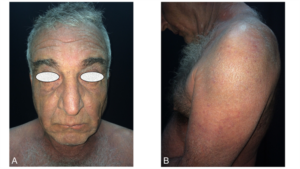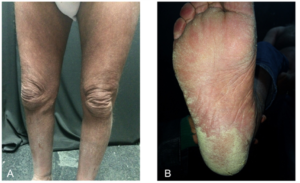Rogério Nabor Kondo1*, Karina da Silva Presser2, Airton dos Santos Gon1
1Dermatologist, Professor of Dermatology, Hospital Universitário, State University of Londrina, Paraná, Brazil
2Medical Student, State University of Londrina, Londrina- Paraná, Brazil
*Correspondence author: Rogério Nabor Kondo, MD, Dermatologist, Professor of Dermatology of Hospital Universitário, State University of Londrina, Paraná, Brazil; Email: [email protected]
Published Date: 31-08-2024
Copyright© 2024 by Kondo RN, et al. All rights reserved. This is an open access article distributed under the terms of the Creative Commons Attribution License, which permits unrestricted use, distribution, and reproduction in any medium, provided the original author and source are credited.
Abstract
Exfoliative erythroderma is a syndrome characterized by erythema and scaling that affects more than 90% of the body surface. In contrast, Sézary Syndrome is a rare and harmful variant of cutaneous T-cell lymphoma, defined by a triad: circulation of neoplastic T-cells, erythroderma and lymphadenopathy, the latter of which may or may not be present. We report a case of an erythrodermic patient, with the etiological cause confirmed as Sézary Syndrome.
Keywords: Erythroderma; Cutaneous T-Cell Lymphoma; Sézary Syndrome
Introduction
Exfoliative Erythroderma (EE) is a rare syndrome characterized by erythema and scaling affecting more than 90% of the body surface. It can be a consequence of an exacerbated primary dermatosis, a drug reaction or a neoplastic cause, such as cutaneous T-cell lymphoma, also known as Mycosis Fungoides (MF) [1].
Sézary Syndrome (SS) is a rare (1:10,000,000) and aggressive variant of cutaneous T-cell lymphoma, characterized by a triad: a) circulation of neoplastic T-cells, b) erythroderma, c) lymphadenopathy, which may or may not be present [2].
In this paper, we report a case of exfoliative erythroderma in which Sézary syndrome was confirmed.
Case Report
Patient, male, 59 years old, white, married, truck driver, was referred to the dermatology service due to lesions that began in the crural region and spread throughout the body, accompanied by intense itching, with progression over 5 months. On clinical examination, he had generalized erythema and scaling (Fig. 1), palmar-plantar hyperkeratosis (Fig. 2) and a palpable lymph node with a fibroelastic consistency in the left anterior cervical region. He also presented right axillary lymphadenopathy and palpable lymph nodes in both inguinal regions.
Given the hypothesis of EE and the initiation of etiological investigation, an anatomical-pathological analysis of the first biopsy was requested, which had been performed at another service. This sample showed only chronic spongiotic eczema. Meanwhile, laboratory tests revealed a CD4/CD8 ratio of 13.78 and a new biopsy was performed, demonstrating epidermotropism (Fig. 3).
The immunophenotyping of peripheral blood hematological neoplasia showed 38% lymphoid cells, approximately half of which were represented by cells with condensed chromatin, some convoluted and basophilic cytoplasm (Sezary’s cells).
Two lymphoid populations were analyzed: R1 (9.15%) and R2 (7.36%). The R1 immunophenotype demonstrated 57% (5.22% of the total cells) of T-lymphocytes CD2+, T CD3++ and T CD5++. In contrast, 45% were CD4++ T helper lymphocytes and 10% were CD8+++ cytotoxic T-lymphocytes. The R2 immunophenotype demonstrated 88% (6.5% of total cells) of T-lymphocytes CD2+, CD3++, CD4 of weak to moderate intensity and CD5 ++, with partial loss of CD7 antigen expression, hyperexpression of the CD25 antigen and loss of CD26 expression, corresponding to a population with an anomalous immunophenotype.
The interpretation of immunophenotyping suggested chronic T-lymphocyte proliferation in the circulating phase, which corresponds to Sézary cells. It is concluded that the set of clinical, morphological and immunophenotypic data suggested that it was SS. The bone marrow biopsy showed the absence of infiltration of the neoplasm.

Figure 1: A: Erythematous and infiltrated lesions on the face; B: Erythematous and scaly lesions on arms and trunks.

Figure 2: A: Erythematous and scaly lesions on lower limbs; B: Plantar keratoderma.

Figure 3: A: Epidermotropism (Hematoxylin and eosin stain, 100x magnification); B: Detail (400x).
Discussion
SS was first described in 1938. It is a rare and aggressive variant of cutaneous T-cell lymphoma or MF, which is a non-Hodgkin lymphoma characterized by a triad: a) circulation of neoplastic T cells, b) erythroderma and c) accompanied, which may or may not be present [3].
Erythrodermic MF (MF with more than 90% of the body surface affected) is differentiated from SS by the absence or low amount of circulating Sézary’s cells and is considered a progression of MF [2,3,4]. These can present from a simple erythema to exfoliative erythroderma, with all of the following symptoms: palmar and plantar hyperkeratosis, hypothermia and alopecia [5].
The diagnostic criteria for SS are: A) 90% or more of the body surface with erythema and desquamation (EE), B) abnormal lymphocyte count, C) presence of Sézary cells in the peripheral blood and D) increased CD4+ cells in peripheral blood, with a CD4/CD8 ratio > 10, as in the presented case [3].
Although EE is a major criterion for the diagnosis of SS, cases have been described without initial erythroderma, however these patients met criteria for high tumor burden in the blood [6].
Studies demonstrate that SS and erythrodermic MF present less specific histopathological findings than classic MF, with less epidermotropism, Pautrier microabscesses and fewer halo lymphocytes, sometimes presenting a lichenoid inflammatory infiltrate [5]. Due to this, it is not uncommon for the diagnosis of cutaneous lymphoma or MF to require multiple biopsies at different stages of evolution, as the cutaneous inflammation itself can mask the findings of epidermotropism [2].
The differential diagnosis of SS would be with pharmacodermias, psoriasis, pityriasis rubra pilaris, pemphigus foliaceus and other dermatoses in their erythrodermic form [1].
There is no pathognomonic or unique clinical manifestation of SS in relation to the differential diagnoses caused by other etiologies of EE, as palmoplantar hyperkeratosis and adenomegaly may be present in other dermatoses with secondary infection, such as psoriasis. Therefore, in the case of EE, the hypothesis of SS must be considered from the beginning of the investigation [7].
Treatment is divided into skin-directed therapies (topical treatments, phototherapy and radiotherapy) and systemic therapies (biological response modifiers, targeted therapies and chemotherapy). Allogeneic bone marrow transplantation and extracorporeal photopheresis are other treatment modalities used in selected cases [4].
The patient in this case was initially treated with Interferon, 5 million international units subcutaneously, 3 times a week, at an oncology service in the city; however, he developed complications and unfortunately, died due to sepsis.
Conclusion
Sézary syndrome is a rare form of MF/cutaneous T-cell lymphoma. With this report, we hope to contribute to the awareness of the disease and assist in the diagnosis and management of similar cases.
Conflict of Interests
The authors declare that there is no conflict of interest for this paper.
References
- Kondo RN, Samesima‐Singh B, Araújo MCP, Ferreira VP, Marani JA, Gon AS. Erythroderma: clinical and etiological study of 88 cases seen in a tertiary hospital over 25 years. An Bras Dermatol. 2024;99:586-9.
- Latzka J, Trautinger F. Mycosis fungoides and Sézary syndrome – Review and outlook. J Dtsch Dermatol Ges. 2023;21(4):386-91.
- Stoll JR, Willner J, Oh Y, Pulitzer M, Moskowitz A, Horwitz S, et al. Primary cutaneous T-cell lymphomas other than mycosis fungoides and Sézary syndrome. Part I: Clinical and histologic features and diagnosis. J Am Acad Dermatol. 2021;85(5):1073-90.
- Sanches JA, Cury‐Martins J, Abreu RM, Miyashiro D, Pereira J. Mycosis fungoides and Sézary syndrome: focus on the current treatment scenario. An Bras Dermatol. 2021;96:458-71.
- Miyashiro D, Sanches JA. Mycosis fungoides and Sézary syndrome: clinical presentation, diagnosis, staging and therapeutic management. Front Oncol. 2023;13:1141108.
- Thompson AK, Killian JM, Weaver AL, Pittelkow MR, Davis MD. Sézary syndrome without erythroderma: A review of 16 cases at Mayo Clinic. J Am Acad Dermatol. 2017;76(4):683-8.
- Guglielmo A, Patrizi A, Bardazzi F, Pileri A. Erythroderma: psoriasis or lymphoma? A diagnostic challenge and therapeutic pitfall. Ital J Dermatol Venerol. 2022;157(2):154-7.
Article Type
Case Report
Publication History
Received Date: 05-08-2024
Accepted Date: 23-08-2024
Published Date: 31-08-2024
Copyright© 2024 by Kondo RN, et al. All rights reserved. This is an open access article distributed under the terms of the Creative Commons Attribution License, which permits unrestricted use, distribution, and reproduction in any medium, provided the original author and source are credited.
Citation: Kondo RN, et al. Sézary Syndrome as an Etiological Cause of Erythroderma: A Case Report. J Dermatol Res. 2024;5(2):1-4.

Figure 1: A: Erythematous and infiltrated lesions on the face; B: Erythematous and scaly lesions on arms and trunks.

Figure 2: A: Erythematous and scaly lesions on lower limbs; B: Plantar keratoderma.

Figure 3: A: Epidermotropism (Hematoxylin and eosin stain, 100x magnification); B: Detail (400x).


